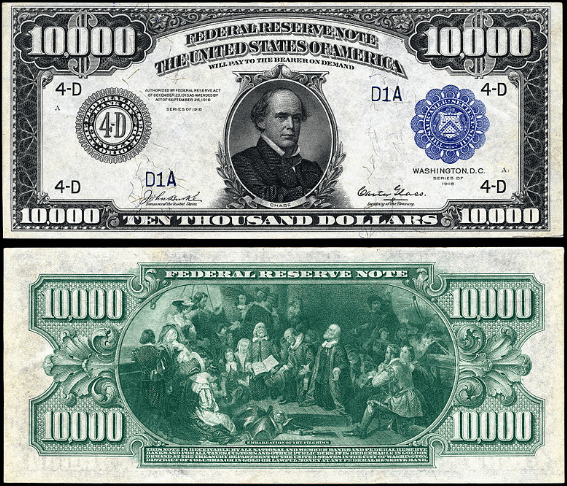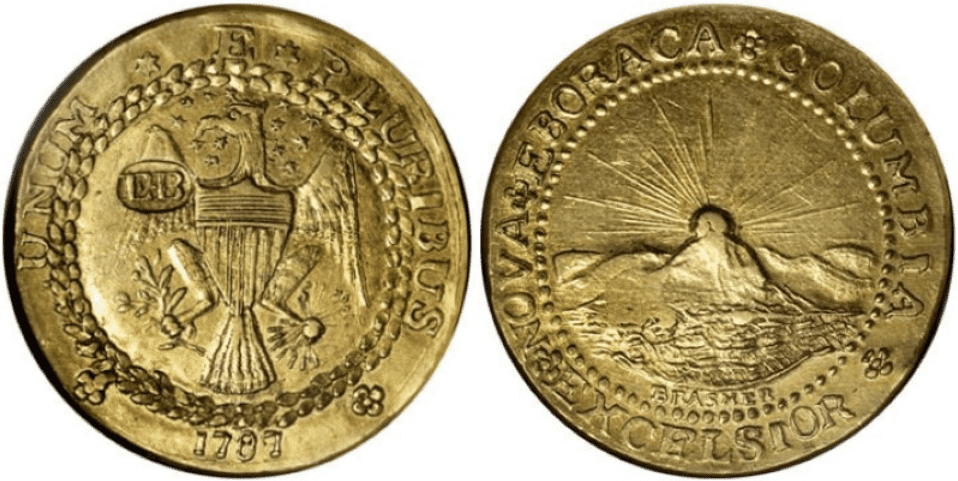Despite the country’s short existence, the United States has a complex currency history with various banknotes, error misprints, and limited editions that could be worth a lot of money.
The United States Mint started issuing coins in 1792 at par with the Spanish American silver dollar, adding new denominations and often changing the face of the banknotes over the years that followed.
Coin experts, known as Numismatics, have searched for valuable coins and banknotes, explaining US history through different denominations. The most surprising fact is that many paper bills and gold coins are worth much more than some of the most beautiful homes in the country.
From rare dollars to accidental coins, you would be surprised to see the most valuable and rarest US currencies on our list and lucky to find them in your collection!
9. 1934 Federal Reserve Note
Sold: 2015
Face Value: $10,000
Grading: PCGS CU 64

photo source: Wikipedia
The Federal Reserve Notes is the highest denomination of the United States currency, minted in large-note format from 1914 to 1928 and from then to today in small-note.
This particular note was minted in 1934, and the front side has a portrait of an American politician Salmon Portland Chase.
It’s unknown how many notes were printed, but one was sold for $105,000 in 2015 by Manifest Auction House. Previous to the sale, the $10,000 bill was a part of the Binion’s Horse Shoe One Million Dollar display at Binion’s Casino in Las Vegas. The casino sold the note in the early 2000s.
Did you know?
Federal Reserve Notes consist of 75 percent cotton and 25 percent linen, nicknamed the Greenbacks due to using the green ink on the back. The bill from 1934 has a painting of the Embarkation of the Pilgrims (1843) by Robert W. Weir.
8.1863 Gold Certificate
Sold: 2013
Face Value: $100
Grading: PCGS 40

photo source: Wikipedia
Gold certificates were issued as replacement money from 1865 to 1934, a more convenient way to pay in gold instead of coins. This Gold Certificate from 1863 is rare due to the year it was printed – earlier than the rest, and because only three notes are in circulation. Two are in the Smithsonian Institution.
These notes had black, green, or red ink, while the one pictured has an orange reverse side, resulting in the nickname “goldbacks” or “yellow boys.” The front side shows a vignette of an eagle with a shield underneath and a small red Seal with Colby and Spinner signatures.
Did you know?
The third gold certificate is in private ownership after selling for $2,115,000 in 2013 through the Heritage Auction House. The owner is unknown, but all three notes were a part of the Schermerhorn Collection before being confiscated by the US Secret Service.
7. 1891 Treasure Note
Sold: 2013
Face Value: $1,000
Grading: PCGS 45

photo source: Wikipedia
Only two examples of 1891 1,000-dollar bills are known to exist, and one was sold for $2,585,000 in 2013 by the Heritage Auction House.
A portrait of General George Meade is on the face, much like the following note on the list, while the reverse side is greenback with one thousand dollars written in bold.
1891 Treasure Note is one of the United States government’s most well-known series under the Sherman Silver Purchase Act’s authority. This note shares its design with “Grand Watermelon,” but the reverse side changed a year after Watermelon was issued.
Did you know?
The series was minted from 1890 to 1893 in denominations of $1, $2, $5, $10, $20, $50, $100, and $1,000. A 50-dollar bill arrived in 1891, and there were plans for a $500 note, but it was never officially issued.
6. 1890 Grand Watermelon
Sold: 2014
Face Value: $1,000
Grading: PCGS 50

photo source: Live Auctioneers
The holy grail of currency, as collectors call it, this 1890 is considered to capture the US currency perfectly. It got its nickname “Grand Watermelon” due to distinctive significant green zeros on the reverse side of the note that resembles the said fruit.
Watermelon ranks no.1 in 100 Greatest American Currency Notes, and it’s one of the rarest notes, with only seven left in circulations. An anonymous buyer bought this note for $3,290,000 in 2014. General George Meade is on the face of the note, while one thousand dollars is on reverse.
Did you know?
This banknote has three varieties: Fr.379a (1890) with a large brown Treasure Seal and Rosecrans and Huston signatures; Ft.379b with a small red Treasure Seal and signatures by Rosecrans and Nebecker and Fr.379c signed by Nebecker, Tillman, Morgan, and Rosecrans in a small red Seal.
5. 1913 Liberty Head
Sold: 2018
Face Value: 5C
Grading: PCGS PR 66

photo source: PCGS
The Indian Head nickel came instead of the Liberty Head nickel in 1913, as the United States Mint doesn’t have official production records of Liberty Head in the same year.
What adds to their rarity and the estimated value is that only five nickles survived: three are in museums, and two are in a private collection.
One of those five was sold for $4,560,000 at Stack’s Bowers Auction in 2018. The front side features the profile of Lady Liberty and a big “V” on the reverse side. Due to this, nickel is sometimes referred to as the “V” coin. A numismatist Samuel Brown owned all five coins before selling them in 1924.
Did you know?
Liberty Head nickel minting occurred from 1883 to 1913, but the production missed to put “CENTS” on the back. This error caused them to remake the molds for coins halfway through, but scammers used this mistake to paint the error coins in gold and pass them off as $5 gold pieces.
4. 1804 Draped Bust
Sold: 2021
Face Value: $1
Grading: PCGS MS 68

photo source: PCGS
This silver and copper 1804 Bowed Liberty Dollar gets its name from the Draped Bust Dollar Series, minted from 1801 to 1804. The coin dates to 1804, but it was minted in the late 1830s for diplomatic purposes or as gifts. With only 15 coins remaining, this is among the rarest currencies.
One of the coins sold for $7,680,000 in a Stack’s Bowers Auction in 2021 in mint condition, but the picture above shows a Class III type with rust around the edges.
The series was struck for circulation by Thomas Jefferson due export of large-tenor coins without returning to the USA.
Did you know?
This Bower’s Auction coin is unique because of a small “D” printed on one of the clouds on the reverse side, indicating that it belonged to a wealthy Numismatist James V. Dexter. All 15 coins are identified by nicknames based on their prominent owners.
3. 1787 Brasher Doubloon
Sold: 2021
Face Value: $16
Grading: PCGS MS 65

photo source: PCGS
Brasher Doubloon’s 16-dollar coin is one of the most sought-after US coins. The series is limited to only seven coins in circulation, struck in 1787 by a New York gold and silversmith Ephraim Brasher. His petition to mind copper coins was denied at first.
This coin is valued at eight Spanish escudos or sixteen Spanish dollars, but one of those seven was sold for $9,360,000 in 2021 by the Heritage Auction House.
The head depicts the sun rising over three mountains, while the reverse shows a heraldic eagle.
Did you know?
The front side bears the legend NOVA EBORACA COLUMBIA EXCELSIOR which translated to New York and America, while excelsior means upward. And the back side has the Latin word UNUM E PLURIBUS meaning one from many.
2. 1794 Flowing Hair
Sold: 2013
Face Value: $1
Grading: PCGS MS 64

photo source: PCGS
Numismatic researchers believe the 1794 Flowing Hair 1-dollar coin is the first silver coin minted by the US Federal Government. The coin is one of the most valuable coins ever, as it sold for $12,000,000 in 2013 in a private sale. The series is scarce, minted from 1794 to 1795.
The obverse side depicts a bust of Lady Liberty, while a bald eagle with its wings spread is on the reverse. The design was made in the same year by Robert Scot. The accurate production number is unknown, but it was among the first silver and gold coins struck.
Did you know?
The United States Mint was created in 1792 by Congress with the Coinage Act. Mint became an independent agency in 1799 after being a part of the State Department. Today, there are four active mints in Philadelphia, San Francisco, West Point, and Denver.
1. 1933 Double Eagle
Sold: 2021
Face Value: $20
Grading: PCGS MS 65

photo source: Sothebys
The most expensive and rarest US Currency on the list is also the most valuable coin ever sold. The title belongs to 1933 Double Eagle, a 20-dollar gold coin. The series, sculpted by a famous American sculptor Augustus Saint-Gaudens, had 445,500 coins minted, but none officially circulated.
The Double Eagle is also the rarest US coin on the market since all the coins except two were ordered to be melted down. One of those two sold for $18,900,000 in 2021 at a Sotheby’s Auction. The estimate for this creamy gold coin was around $15 million due to its mint state grading.
Did you know?
The coin has Lady Liberty holding a torch and an olive branch, and the reverse side has a bald eagle in flight. A great collector, King Farouk of Egypt. purchased one double eagle coin in 1944, which was considered lost until the Auction in 2021.









